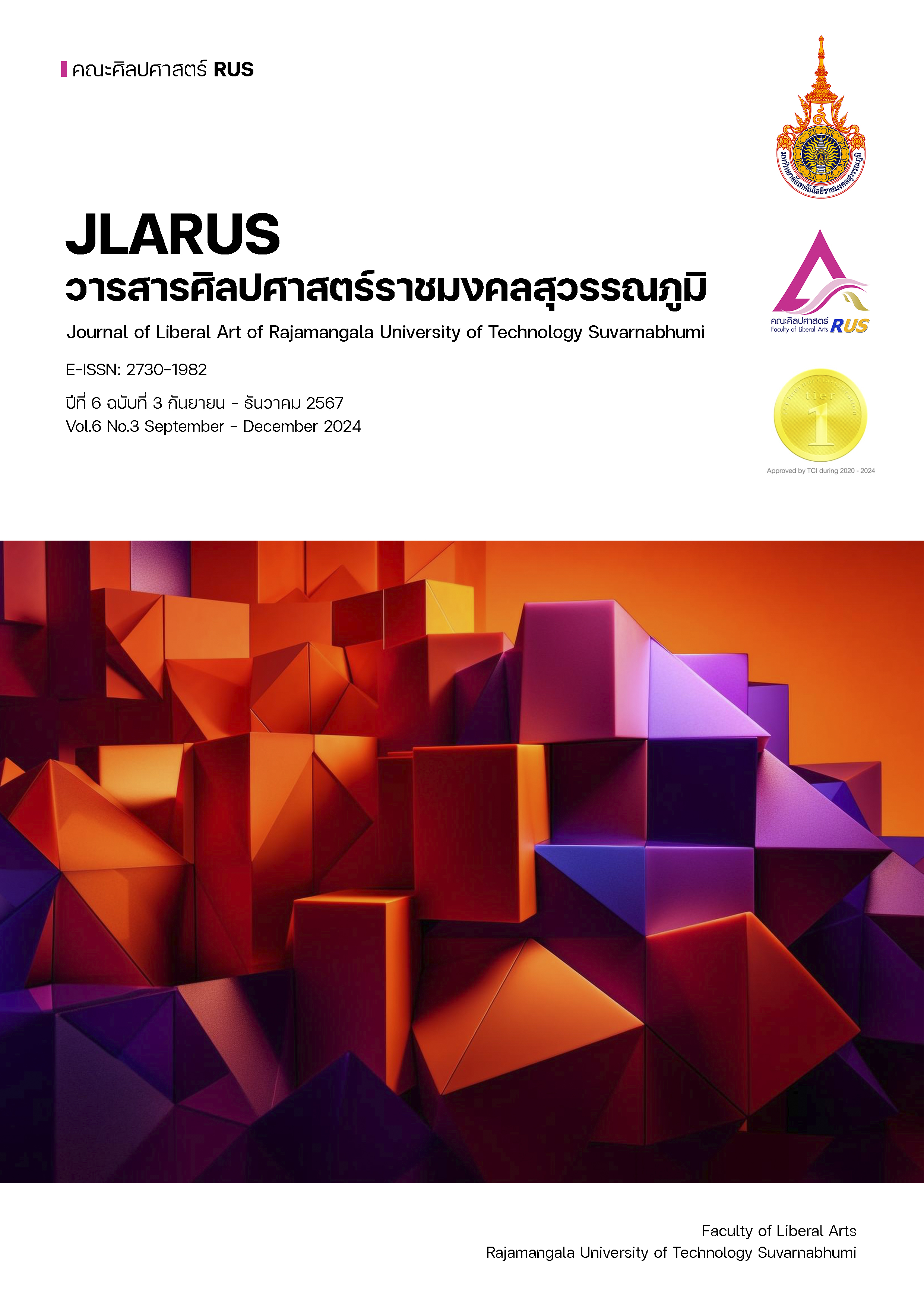ANALYSIS OF CONSUMER BEHAVIOR AND CUSTOMER JOURNEY FOR THE GOAT PRODUCTS IN PHRA NAKHON SRI AYUTTHAYA PROVINCE
Main Article Content
Abstract
This article presents a mixed-methods research study aimed at analyzing consumer behavior and the customer journey for goat products in Phra Nakhon Si Ayutthaya province. Data on consumer behavior were collected from a sample group of 943 consumers of goat products at restaurants offering goat-based dishes in Phra Nakhon Si Ayutthaya province., The samples were divided into accidental sampling before and after awareness-building (before the study: 523 samples, after the study: 400 samples). Additionally, a targeted sample group of 20 customers was chosen for in-depth interviews to analyze the consumer journey. The research results revealed two main consumer groups: 1) existing goat consumers, who were local residents with purchasing power, aware of the nutritional benefits, and chose to consume goat products due to the product itself and its taste; and 2) new consumers, who had not previously consumed goat products primarily due to lack of exposure to the product and hesitancy to taste it. The key factors influencing the decision to consume goat products consisted of, in order of importance: the product itself, followed by marketing/promotion efforts, price, location of purchase, the restaurant’s image, family/friends, service, and restaurant staff. Regarding the customer journey, consumers typically began by becoming aware of the product through social media pages of restaurants and promotional pages. In the attraction phase, consumers sought additional information by asking those who had already tasted the product or by conducting their own research via social media. In the trust phase, younger target groups expressed interest and willingness to taste goat products, driven by the Soft Power trend. This led to the decision-making phase and, ultimately, to the recommendation of goat products to their close acquaintances. The knowledge gained benefits store owners, enabling them to develop marketing strategies that align with customer needs.
Article Details

This work is licensed under a Creative Commons Attribution-NonCommercial-NoDerivatives 4.0 International License.
References
กนกพร ภาคีฉาย, ชุตินันท์ วิลามาศ, ปราชญ์ พวงเงิน, จารุณี ทองอร่าม และกนกกาญจน์ กล่อมเกลา. (2567). ปัจจัยที่ส่งผลต่อการเพิ่มปริมาณความต้องการผลิตภัณฑ์จากแพะในจังหวัดพระนครศรีอยุธยา. วารสารศิลปศาสตร์ราชมงคลสุวรรณภูมิ, 6(1), 239-252. https://so03.tci-thaijo.org/index.php/art/article/view/276221.
ชาย โพธิสิตา. (2554). ศาสตร์และศิลป์แห่งการวิจัยเชิงคุณภาพ. อมรินทร์พริ้นติ้งท์.
ณฐวัฒน์ คณารักสมบัติ และอุทัย ยะรี. (2566). การสื่อสารการตลาดผลิตภัณฑ์ชุมชนเพื่อบรรลุเส้นทางผู้บริโภคในยุค New Nornal. วารสารมนุษยศาสตร์และสังคมศาสตร์ มหาวิทยาลัยราชภัฏอุบลราชธานี, 14(1), 205-214. https://so01.tci-thaijo.org/index.php/humanjubru/ article/view/259309.
ทวีทรัพย์ นาคา, นงนภัส ทองทูล, นันธินี เหรวรรณ, เมธิษา คำเมืองมูล, ศุภณัฐ อ่ำดอนกลอย และจารุพร ตั้งพัฒนกิจ. (2565). การศึกษาพฤติกรรมของผู้บริโภคในช่วงสถานการณ์โควิด-19 ที่มีผลต่อการเลือกใช้เทคโนโลยีอินเทอร์เน็ตของสรรพสิ่ง (IoT) ในธุรกิจร้านอาหาร. วารสารการศิลปศาสตร์ประยุกต์, 15(1), 1–15. https://so01.tci-thaijo.org/index.php /faakmutnb/article/view/255648/174624
.
ปวรพล สอนระเบียน และสุทธนิภา ศรีไสย์. (2566). เส้นทางการตัดสินใจซื้อผลิตภัณฑ์เสริมอาหารของผู้บริโภคไทย. วารสารการสื่อสารและการจัดการ นิด้า, 9(1), 1-17. https://so12.tci-thaijo.org/index.php/jcmn/article/view/517.
ปฏิพร ภมร และธนกฤต วงศ์มหาเศรษฐ์. (2567). การศึกษาอิทธิพลของปัจจัยทางการตลาดที่มีต่อความตั้งใจในการใช้บริการซ้ำของธุรกิจร้านอาหารปิ้งย่างสไตล์เกาหลี แบรนด์ซูกิชิ ในจังหวัดชลบุรี. วารสารสังคมศาสตร์และมนุษยศาสตร์ สถาบันอุดมศึกษาเอกชนแห่งประเทศไทย, 30(1), 79-91. https://so06.tci-thaijo.org/index.php/apheit-ss/article/view/270748
พิเชษฐ์ วงศ์เกียรติ์ขจร. (2559). การวิจัยเชิงคุณภาพ. ส.เอเชียเพรส.
รภัสศา นนทวงษ์ และสุพิชา บูรณะวิทยาภรณ์. (2566). อิทธิพลของการตลาดดิจิทัลที่ส่งผลต่อการตัดสินใจใช้บริการร้านกาแฟชาวดอยในกรุงเทพมหานคร. วารสารมนุษยศาสตร์และสังคมศาสตร์ มหาวิทยาลัยเอเชียอาคเนย์, 7(2), 129-142. https://so05.tci-thaijo.org/index.php/saujournalssh/article/view/266346/179348.
รุจาภา แพ่งเกษร. (2566). พฤติกรรมการใช้สื่อโซเชียลในการรับรู้ข้อมูลและการตัดสินใจซื้อสินค้าและใช้บริการ. วารสารเศรษฐศาสตร์และบริหารธุรกิจปริทัศน์, 19(2), 129-143. https://so15.tci-thaijo.org/index.php/bae/article/view/372/280.
วรรณดี สุทธินรากร. (2556). การวิจัยเชิงคุณภาพ: การวิจัยในกระบวนการทัศน์ทางเลือก. สยามปริทัศน์.
วรธร ศิริวรรณ และศักดิ์สิทธิ์ บุศยพลากร. (2567). ปัจจัยที่ส่งผลต่อการตัดสินใจซื้อผักไฮโดรพอนิกส์ทางออนไลน์ในเขตกรุงเทพมหานครและปริมณฑล. วารสารสังคมศาสตร์ปัญญาพัฒน์, 6(2), 405–420. https://so06.tci-thaijo.org/index.php/JSSP/article/view/268791/183 700.
วิศนันท์ อุปรมัย และประภาศรี พงศ์ธนาพาณิช. (2566). การสื่อสารการตลาดดิจิทัลสำหรับร้านขนมไทยในนยุคปกติวิถีใหม่. วารสารเกษมบัณฑิต, 24(1), 1-17. https://so04.tci-thaijo .org/index.php/jkbu/article/view/261000/179298.
สุภกร ตันวราวุฒิชัย และบุญไทย แก้วขันตี. (2564). ปัจจัยการตลาดแบบดิจิทัล การโฆษณาผ่านสื่อสังคมออนไลน์และความสามารถด้านโลจิสติกส์ที่ส่งผลต่อการตัดสินใจซื้อสินค้าผ่านช่องทางพาณิชย์อิเลคทรอนิกส์ของผู้บริโภคในกรุงเทพมหานคร. วารสารเกษตรศาสตร์ธุรกิจประยุกต์, 15(22), 23–40. https://so04.tci-thaijo.org/index.php/KAB/article/view/ 245016.
หัว เซิง เหว่ย, บุญฑวรรณ วิงวอน และมนตรี พิริยะกุล. (2566). อิทธิพลของสังคมออนไลน์และความพึงพอใจเป็นปัจจัยคั่นกลางของการตลาดแบบผสานทุกช่องทางไปสู่ความตั้งใจกลับมาซื้อซ้ำของผู้บริโภคในธุรกิจออนไลน์มณฑลเสฉวน สาธารณรัฐประชาชนจีน. วารสารวิจัยวิชาการ, 6(4), 75–96. https://so06.tci-thaijo.org/index.php/jra/article/view/259854.
Court, D., Elzinga, D., Mulder, S., & Vetvik, O. J. (2009). The consumer decision journey. McKinsey Quarterly, 3(1), 1-11.
Faul, F., Erdfelder, E., Lang, A.-G., & Buchner, A. (2007). GPower 3: A flexible statistical power analysis program for the social, behavioral, and biomedical sciences. Behavior Research Methods, 39(2), 175-191. http://doi:10.3758/BF03193146.
Field, A. (2013). Discovering Statistics Using IBM SPSS Statistics (4 th ed.). Sage Publications.
Kotler, P., & Keller, K. L. (2016). Marketing Management (15 th ed.). Pearson.
Kotler, P., Kartajaya, H., & Setiawan, I. (2016). Marketing 4.0: Moving from Traditional to Digital. Wiley.
Kotler, P. (2003). Marketing Management (11 th ed.). Prentice-Hall.
Lemon, K. N., & Verhoef, P. C. (2016). Understanding customer experience throughout the customer journey. Journal of Marketing, 80(6), 69-96. https://doi.org/10. 1509/jm.15.0420.
Makowska, M., Boguszewski, R., & Hrehorowicz, A. (2024). Generational Differences in Food Choices and Consumer Behaviors in the Context of Sustainable Development. Foods, 13(4), 521. https://doi.org/10.3390/foods13040521.
Schiffman, L. G., & Wisenblit, J. L. (2019). Consumer Behavior (12 th ed.). Pearson.
Solomon, M. R. (2018). Consumer Behavior: Buying, Having, and Being (12 th ed.). Pearson.
Tuckman, B. W. (1999). Conducting Educational Research (5 th ed.). Harcourt Brace.


